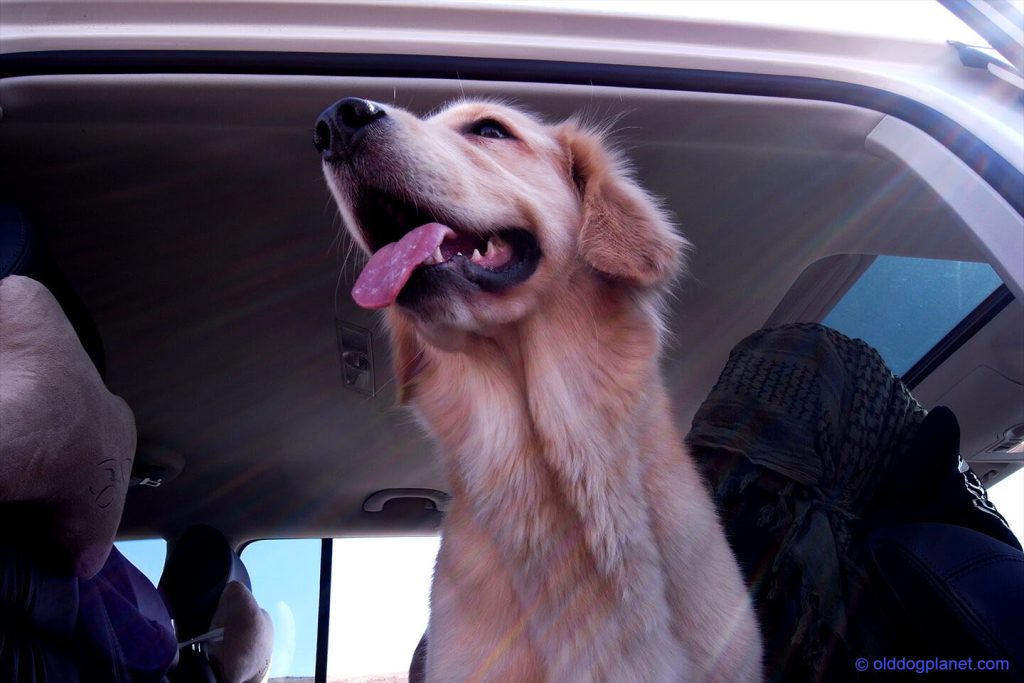Table of Contents
ToggleThis summer is expected to be hotter than usual across much of the United States, according to reports. I’m a little concerned about it. This year marks the eighth birthday of my Golden Retriever. She has reached the age of an old dog. Given that she has been a girl who can’t stand the heat since she was a puppy, figuring out how to keep an old dog cool in hot weather will be a challenge that I will face all summer.
I used to take her to the beach to play in summer, and she would always rush into the waves to pick up her favorite ball and run back to me. She has never had heat stroke in the last few years, even after playing at the beach for 1 or 2 hours straight in the scorching sun. But now I need to reconsider how she lives, travels, and plays during the summer.
Aging is an unavoidable process, and I can now feel the decline of her physical strength and fitness. If I ignore her changes and continue to treat her like a sturdy young dog, it could seriously harm her in the heat of summer.
Do older dogs overheat easily?
I did some research and discovered that older dogs are more likely to suffer from heatstroke than younger dogs. This is due to the dog’s declining ability to regulate body temperature as it ages. When the temperature is not too high, dogs primarily use their paws and ears to dissipate heat, though the evaporation of liquid on the nose can also help. When the dog’s body temperature rises too high, wheezing becomes the primary method of heat dissipation for the dog.
Assume that the heat dissipation capacity of young dogs is 10, and that of old dogs is 7. The hot air and sunlight now delivers 8 units of heat per hour to dogs of similar size and hair. Young dogs can easily emit these 8 units of heat, whereas old dogs can only emit 7 units due to their heat dissipation capacity of only 7, and the remaining 1 unit of heat cannot be quickly released and accumulates in the old dog, which eventually causes the old dog’s body temperature to rise to an unbearable level, causing the old dog to suffer from heatstroke.
In the past, your dog could stay in 100 °F for 2 hours without getting heatstroke, but as he gets older, he may overheat in 20 minutes under 100 °F.
What temperature is too hot for an old dog?
According to Animal Welfare Act and Animal Welfare Regulations (Issued May 2022, USDA), the air temperature surrounding the dog in indoor housing facilities must not rise above 85 °F (29.5 °C) for more than 4 consecutive hours when dogs or cats are present.
Auxiliary ventilation, such as fans, blowers, or air conditioning must be provided when the air temperature surrounding the dog is 85 °F (29.5 °C) or higher. The relative humidity must be maintained of 30 to 70 percent.
We can conclude from this that an ambient temperature of more than 85 °F (29.5 °C) is too hot for a dog to bear without ventilation and cooling.
Even if we don’t use air conditioners or electric fans, I believe 85 °F (29.5 °C) is tolerable for most people because the large area of human skin covered with sweat glands gives us a strong ability to dissipate heat. We may be one of the most heat-dissipating mammal species.
However, dogs cannot dissipate heat as efficiently as humans because they are covered in thick hair, have only a few sweat glands on the paw pads to help with heat, and the most of the heat is dissipated primarily through panting.
Do older dogs have a harder time with heat?
As far as I can tell, my 8-year-old Golden Retriever now wheezes and walks restlessly when the room temperature rises above 27 °C, which is significantly lower than the 85 °F (29.5 °C) prescribed by the Animal Welfare Act, and seeks cooler areas to cool off. She also consumes more water and consumes it more frequently than usual.
When she exhibits these behaviors, I always immediately implement various cooling measures for her, rather than waiting for her to cool down on her own, because it is extremely difficult for domestic dogs, particularly older dogs, to achieve effective cooling through their own wheezing when ambient temperature rises too high, resulting in heatstroke, a fatal acute symptom, even if seeing a vet in time saves the dog’s life, it is also possible to cause the following irreversible hazards during heatstroke:
-
Acute liver necrosis
Heatstroke or other forms of thermal injury can result in acute liver necrosis, which is a permanent liver injury.
-
Blood in the urine
Heatstroke can also cause blood in the urine, which is a sign of a large number of blood cells pouring into the kidneys and blocking and damaging the filtration function.
-
Hypernatremia
Heatstroke can also cause hypernatremia, which causes cell dehydration, causing a large number of vascular and brain tissue cells to lose water and contract, resulting in ataxia, convulsions, and other symptoms in dogs, as well as serious consequences from thrombus and cerebrovascular infarction.
How do I know if my dog is overheated?
Knowing how to tell if my dog is overheating is especially important for keeping older dogs safe from the height of summer. Here are symptoms of heat stroke of different stage.
-
Early stage of heatstroke
- Red eyes - Excessive drooling - Gasp for breath
-
Middle stage of heatstroke
- Unconsciousness - Dull eyes - Unstable respiratory frequency
-
Late stage of heatstroke
- Foaming at the mouth - Coma - Weak pulse - Pale or bluish purple gums - Punctate bleeding or ecchymosis on the skin or mucosa
If your dog has the above symptoms, there is a good chance that your dog has heatstroke. But not all of these symptoms are representative, that is to say, it is impossible to judge whether a dog has heatstroke by a few symptoms alone.
How to know if your dog has heat stroke accurately? Here rectal temperature is the most important reference in addition to the above symptoms. If your dog exhibits the symptoms listed above and its rectal temperature is higher than 103 °F (39.4 °C) before any cooling measures are taken, the dog is suffering from heatstroke.
How to cool a dog down with heat stroke?
Ice is often the first cooling choice that comes to mind, but using ice directly to cool dogs with heatstroke is not a wise choice, just as frozen hands cannot be directly soaked in hot water.
The excessive temperature difference cools the body surface of heatstroke dogs too quickly, causing skin vasoconstriction, which forces a large amount of blood back to the internal organs while less blood flows to the skin, causing heat to accumulate in the internal organs rather than flow to the skin to dissipate. This raises the body temperature and causes visceral damage to dogs.
According to extensive practical experience, the best cooling method is to spray cool tap water on the dog rather than cold water, ice water, or ice cubes, while using a fan or air-conditioned running in low fan speed to cool down the dog and lowering the dog’s core temperature to 103 °F (39.4°C) in 30 to 60 minutes. Do not expose the dog to a MED or HI fan speed at close range, as this will cause blood reflux and damage to the internal organs.
It is also necessory to measure the dog’s rectal temperature with a thermometer. When the dog’s body temperature falls below 103 °F (39.4°C), you should stop cooling the dog to avoid hypothermia and other symptoms.
In practice, it is not recommended that dog owners spend 30-60 minutes at home to cool the dog, but should immediately send the dog to the vet for treatment once have the initial cooling done. The following steps are for reference:
-
Start the car and turn on the air conditioner for 5-10 minutes to bring the temperature down to room temperature.
-
Carry spraying utensils and enough cold water.
-
Take some towels or Kleenex to avoid soaking the seat with too much water.
-
At least two people work together, one for driving, the other to continuously observing the dog's symptoms and spraying water to cool the dog when needed.
How to keep old dogs cool in summer?
-
Monitoring temperature and humidity
The first step is to keep an eye on the temperature and humidity levels in the dog’s living area. Dr. Justine Lee's theory states that if the temperature (°F) plus humidity (percent) added together exceeds 150, it is too hot for dogs. We can set the sensor alarm threshold to temperature 100 °F, humidity 50%, or temperature 98 °F, humidity 52% using this formula. When the sensor goes off, it's time to cool down your dog.
-
Maintain the flow of air
You can keep the indoor air flowing with a fan or an air conditioner, but it is difficult to keep the air flowing if you open the window alone when there is no wind outside.
-
Place the dog in the room's coolest spot
In general, the first floor is cooler than the attic. Cooler areas will be those near doors and windows that are not directly exposed to the sun.
-
Give the dog plenty of water to drink
Plenty of fresh water is always a essential for your old dogs. You can also give the dog a large block of ice to lick. When the dog is not suffering from heatstroke, it is safe to lick ice cubes.
-
Blackout plan
When the dog owner needs to be away from home for more than 4 hours, please consider the emergency of power outage or air conditioner or fan shuts down unexpectedly. Do not lock the dogs in a room or crate, but allow them to move freely indoors so that they can look for cool areas. If possible, place ice cubes that can last at least 3 hours in the dog's activity area for licking or ice bags to lower the ambient temperature.
How to keep senior dog cool at the beach?
If you are taking your old dog on a summer outing or a beach vacation, it is critical that you keep the dog cool. Here is a guide to keeping dogs cool on the beach:
-
A cooling pad for your dogs
When your abdomen comes into contact with hot sand, you must bounce out of it, and so do dogs, whose soft bellies have sparse hair and are easily scalded by scalding sand. Give your dog a cooling pad to keep the heat from the sand at bay and make sure the cooling pad is always shielded from the sun by a beach umbrella.
-
Sand sunscreen
Apply the appropriate amount of wet sand to the dog's back and head. Elephants invented this method. To keep cool, these tropical animals spray wet soil on their backs and heads to block direct sunlight.
-
Drinking water
Drinking water utensils and adequate drinking water are required. The heat from the sun on the beach will cause the dog to lose water constantly. Furthermore, when swimming in the sea, the dog will drink a lot of sea water and swallow a lot of sea sand. They usually remove these salt-rich sundries through pooping, which dehydrates their intestines and makes replenishing fresh water the only option.




